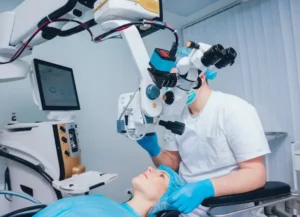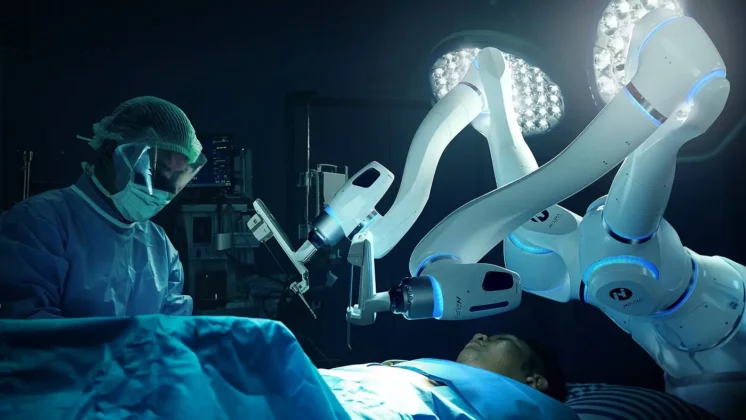n the ever-evolving realm of medical advancements, cataract surgery has taken a transformative leap. Gone are the days of extended recovery and daunting procedures. Thanks to technologies like Robotic Cataract Surgery, patients now enjoy a smoother, faster, and more precise treatment experience. In this guide, we’ll delve deep into the ins and outs of this cutting-edge approach, its myriad benefits, and an honest breakdown of costs. Curious about how robotic technology is reshaping the world of cataract treatment? Stay with us, and let’s unravel the marvels together!
Contents
What is Robotic Cataract Surgery?
 Imagine a world where machines and humans work in perfect harmony, ensuring precision and efficiency, especially in delicate tasks. Welcome to the realm of Robotic Cataract Surgery! Unlike the traditional methods where surgeons manually handle most of the procedure, this cutting-edge approach uses state-of-the-art technology to assist.
Imagine a world where machines and humans work in perfect harmony, ensuring precision and efficiency, especially in delicate tasks. Welcome to the realm of Robotic Cataract Surgery! Unlike the traditional methods where surgeons manually handle most of the procedure, this cutting-edge approach uses state-of-the-art technology to assist.
At its core, Robotic Cataract Surgery leverages laser and ultrasound waves. Here’s the cool part: instead of using scalpels or blades, the surgery utilizes lasers to make precise incisions. Plus, those faulty lenses clouded by cataracts? They’re gently broken up and removed using ultrasound waves. And then finally, placing a fresh artificial lens, all with the help of our robot buddy.
How Robotic Cataract Surgery Works
The marvel of technology has brought us to an era where robots assist in enhancing the precision of medical procedures. If you’re curious about the magic behind Robotic Cataract Surgery, let’s break it down, step by step:
- Preparation with Anesthesia Drops: First off, no need for needles or injections here! The patient’s eye is numbed using specialized anesthesia drops. It ensures a pain-free experience throughout the procedure.
- Harnessing the LenSx Laser: With the eye numbed and prepped, it’s time for our technological star, the LenSx laser, to shine. The laser is used to create highly precise and accurate incisions. No blades or scalpels; just clean, laser-guided precision.
- Softening the Cataract: Once the incisions are made, ultrasonic waves come into play. These waves gently break up the cataract-filled lens, making it easier to remove. This process is called phacoemulsification.
- Removing the Clouded Lens: After the cataract is softened and fragmented, it’s carefully removed from the eye. This step is crucial as it paves the way for the new artificial lens.
- Implanting the New Lens: With the old lens out, an artificial intraocular lens is delicately placed into the eye. This new lens restores clarity and focus, allowing patients to see clearly once again.+
Advantages of Going Robotic
Choosing Robotic Cataract Surgery offers a slew of advantages that traditional methods might fall short on. Let’s delve into the many perks:
- The main highlight of Robotic Cataract Surgery is its reliance on the LenSx laser. This laser brings unparalleled accuracy to the procedure, ensuring the incisions are exact and consistent.
- One of the standout benefits of going robotic is the speed at which patients recover. Since the surgery is less invasive, most patients are back to their routine within a few days, with some noticing improved vision just hours after the procedure!
- No More Blades, Stitches, or Bandages: The advanced laser technique eliminates the need for blades, and since the incisions are so precise, they naturally heal without the necessity of stitches or bandages.
- Since the surgery is blade-free and involves fewer touchpoints, the risk of infections is drastically reduced. It’s a cleaner, more sterile process, further ensuring patient safety.
- Robotic Cataract Surgery is an outpatient procedure. That means no overnight hospital stays. Get the surgery done and be back in the comfort of your home on the same day.
In essence, Robotic Cataract Surgery is not just a step, but a giant leap forward in the realm of eye care. It’s a testament to how technology can enhance medical practices, making surgeries safer, more efficient, and more comfortable for patients.
Cost Analysis: Robotic vs. Traditional Cataract Surgery
When weighing the options for cataract surgery, one of the significant considerations is cost. Here’s a comparative breakdown between the expenses involved in Robotic Cataract Surgery and Traditional Cataract Surgery. While the exact figures can vary depending on the region, clinic, and specifics of the procedure, this table provides a general overview:
| Cost Factors | Robotic Cataract Surgery | Traditional Cataract Surgery |
|---|---|---|
| Technology & Equipment | Higher due to the advanced LenSx laser and other specialized equipment. | Standard surgical tools lead to moderate costs. |
| Expertise Required | Surgeons require specialized training for laser-assisted surgery, which might add to the cost. | Costs can be lower since the technique has been around for a longer time. |
| Facility Fees | Might be higher given the technologically advanced setup and maintenance of equipment. | Traditional setups usually have moderate facility fees. |
| Post-operative Care & Medication | Typically less expensive due to reduced need for medications, fewer follow-up visits, and no stitches or bandages. | Might incur additional costs for post-operative care, including medications and potential follow-up visits. |
| Overall Cost (average) | Starts from ₹50,000 and can go higher depending on the specifics. | Usually less expensive than robotic but varies based on the clinic and region. |
It’s essential to note that while Robotic Cataract Surgery may appear more costly upfront, the benefits, such as faster recovery and reduced post-operative care, can offset some of those costs in the long run.
Conclusion
Navigating the world of cataract surgery can seem daunting, especially with the rapid advancements in technology. Robotic cataract surgery, with its high precision and numerous benefits, stands out as a promising solution for many. If you’re grappling with cataract-related issues and weighing your surgical options, remember that making an informed choice is paramount. At EyeMantra, our dedicated team is poised to guide you through the process, ensuring the best possible outcome for your vision.
If you’re experiencing cataract related problems, Cataract Surgery at EyeMantra can help: Book your free appointment now at 9711116605
FAQs
1. What is the recovery time for robotic cataract surgery?
The recovery time for robotic cataract surgery is notably shorter than traditional surgery. Most patients observe clear vision within a day or two after the procedure. While some minor blurriness can persist for a few days, complete healing usually occurs within 8 weeks. However, it’s crucial to follow post-operative guidelines and attend follow-up appointments to ensure optimal healing.
2. What is the success rate of robotic surgery?
Robotic cataract surgery boasts a high success rate. With the precision of the LenSx laser and reduced room for human error, complications are significantly minimized. Most studies and clinical practices report a success rate above 95%. However, as with any surgical procedure, individual experiences might vary. It’s always best to discuss this with your ophthalmologist.
3. How painful is robotic surgery?
One of the significant advantages of robotic cataract surgery is that it’s virtually painless. Anesthesia drops are applied to numb the eyes, ensuring that patients feel no pain during the procedure. After the surgery, there might be a slight sensation of discomfort or a gritty feeling in the eyes, but this is temporary and often subsides within a day.
4. What is the disadvantage of robotic surgery?
While robotic cataract surgery offers many benefits, there are some potential drawbacks to consider:
- Cost: Robotic surgery can be more expensive upfront due to the advanced technology involved.
- Availability: Not all clinics or hospitals have access to the required technology or trained surgeons for robotic cataract surgery.
- Over-reliance on technology: While technology minimizes human error, it’s not foolproof. There’s always a slight chance of machine malfunction, though it’s rare.
Regardless of these disadvantages, many patients and doctors prefer robotic surgery for its precision, reduced recovery time, and overall benefits in the long term.



